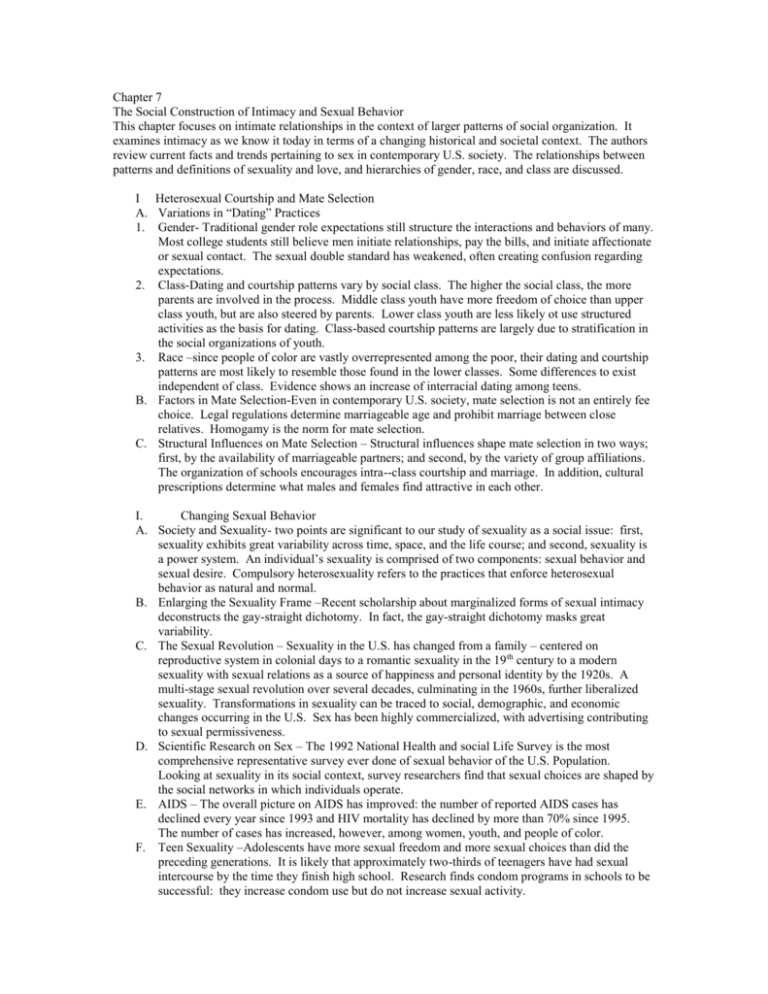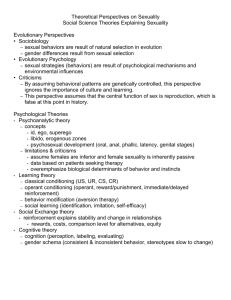
Chapter 7
The Social Construction of Intimacy and Sexual Behavior
This chapter focuses on intimate relationships in the context of larger patterns of social organization. It
examines intimacy as we know it today in terms of a changing historical and societal context. The authors
review current facts and trends pertaining to sex in contemporary U.S. society. The relationships between
patterns and definitions of sexuality and love, and hierarchies of gender, race, and class are discussed.
I Heterosexual Courtship and Mate Selection
A. Variations in “Dating” Practices
1. Gender- Traditional gender role expectations still structure the interactions and behaviors of many.
Most college students still believe men initiate relationships, pay the bills, and initiate affectionate
or sexual contact. The sexual double standard has weakened, often creating confusion regarding
expectations.
2. Class-Dating and courtship patterns vary by social class. The higher the social class, the more
parents are involved in the process. Middle class youth have more freedom of choice than upper
class youth, but are also steered by parents. Lower class youth are less likely ot use structured
activities as the basis for dating. Class-based courtship patterns are largely due to stratification in
the social organizations of youth.
3. Race –since people of color are vastly overrepresented among the poor, their dating and courtship
patterns are most likely to resemble those found in the lower classes. Some differences to exist
independent of class. Evidence shows an increase of interracial dating among teens.
B. Factors in Mate Selection-Even in contemporary U.S. society, mate selection is not an entirely fee
choice. Legal regulations determine marriageable age and prohibit marriage between close
relatives. Homogamy is the norm for mate selection.
C. Structural Influences on Mate Selection – Structural influences shape mate selection in two ways;
first, by the availability of marriageable partners; and second, by the variety of group affiliations.
The organization of schools encourages intra--class courtship and marriage. In addition, cultural
prescriptions determine what males and females find attractive in each other.
I.
Changing Sexual Behavior
A. Society and Sexuality- two points are significant to our study of sexuality as a social issue: first,
sexuality exhibits great variability across time, space, and the life course; and second, sexuality is
a power system. An individual’s sexuality is comprised of two components: sexual behavior and
sexual desire. Compulsory heterosexuality refers to the practices that enforce heterosexual
behavior as natural and normal.
B. Enlarging the Sexuality Frame –Recent scholarship about marginalized forms of sexual intimacy
deconstructs the gay-straight dichotomy. In fact, the gay-straight dichotomy masks great
variability.
C. The Sexual Revolution – Sexuality in the U.S. has changed from a family – centered on
reproductive system in colonial days to a romantic sexuality in the 19 th century to a modern
sexuality with sexual relations as a source of happiness and personal identity by the 1920s. A
multi-stage sexual revolution over several decades, culminating in the 1960s, further liberalized
sexuality. Transformations in sexuality can be traced to social, demographic, and economic
changes occurring in the U.S. Sex has been highly commercialized, with advertising contributing
to sexual permissiveness.
D. Scientific Research on Sex – The 1992 National Health and social Life Survey is the most
comprehensive representative survey ever done of sexual behavior of the U.S. Population.
Looking at sexuality in its social context, survey researchers find that sexual choices are shaped by
the social networks in which individuals operate.
E. AIDS – The overall picture on AIDS has improved: the number of reported AIDS cases has
declined every year since 1993 and HIV mortality has declined by more than 70% since 1995.
The number of cases has increased, however, among women, youth, and people of color.
F. Teen Sexuality –Adolescents have more sexual freedom and more sexual choices than did the
preceding generations. It is likely that approximately two-thirds of teenagers have had sexual
intercourse by the time they finish high school. Research finds condom programs in schools to be
successful: they increase condom use but do not increase sexual activity.
G. Teenage Childbearing –Many scholars believe the national concern about teenage birthrates is
exaggerated. Concerns about teen childbearing are related to race: young Black/African
American and Hispanic/Latina women are more likely to give birth than are young White NonHispanic women.
II.
Differentiated Forms of Intimacy
Gender, class, race, and sexual orientation influence the social construction of intimacy to produce a
wide range of intimate behaviors and experiences.
A. Gendered Love and Sex –Women and men want and expect different things from their intimate
heterosexual relationships.
1. His and Her Sex- The double standard has shaped different expectations that translate into an
imbalance of love and sex in intimate relationships. The model for male sexuality stresses
performance while the female model stresses the emotional relationship. Divergent desire and
expectations present problems for both sexes.
2. His and Her Love- The expectations and style of love vary by gender. The social organization of
love has been linked to societal changes, particularly the economic changes that accompanied
industrialization. Women are more highly motivated to fall in love and do the majority of
“emotion work” in relationships. Men hold hegemony over the courtship process while women –
for economic reasons need marriage more.
3. Same-Sex Orientation and Intimacy – Broad social support networks available to heterosexual
couples and their relationships are missing for gay and lesbian couples. Gender plays an
important part in intimate relationships, similarities are found between lesbian and heterosexual
women as well as between gay and heterosexual men.
4. Social class and Intimacy – The experience of sexuality and love varies by social class. Research
has consistently documented that certain categories of young people are overrepresented among
the sexually active. The NHSLS discovered that sexual behavior is very much class coded.
1. Love and Social class – while most people uphold the ideology of love, there are class differences
in resources to sustain that ideal.
D. Race and Intimacy- Institutional structures of racism create differences in sexual behaviors and
sexual beings.
Poverty, Discrimination, and Institutional Racism shaped race and intimacy contacts.
E. Claiming Control of Intimacy – The ability to separate sexuality from reproduction allows for the
exercise of agency in intimate relationships. People throughout society are struggling to transform
intimate relationships and to enhance pleasure and love.










